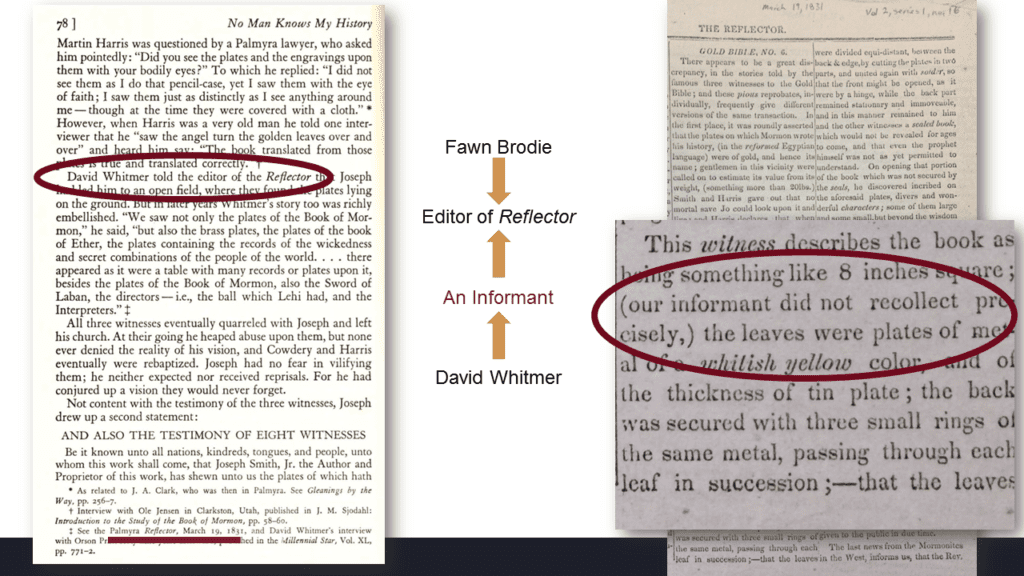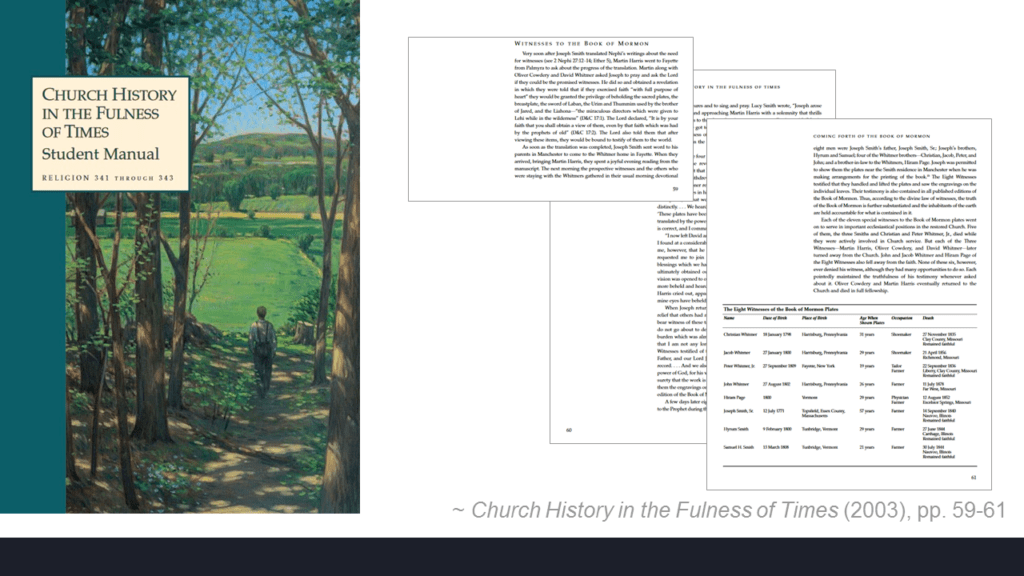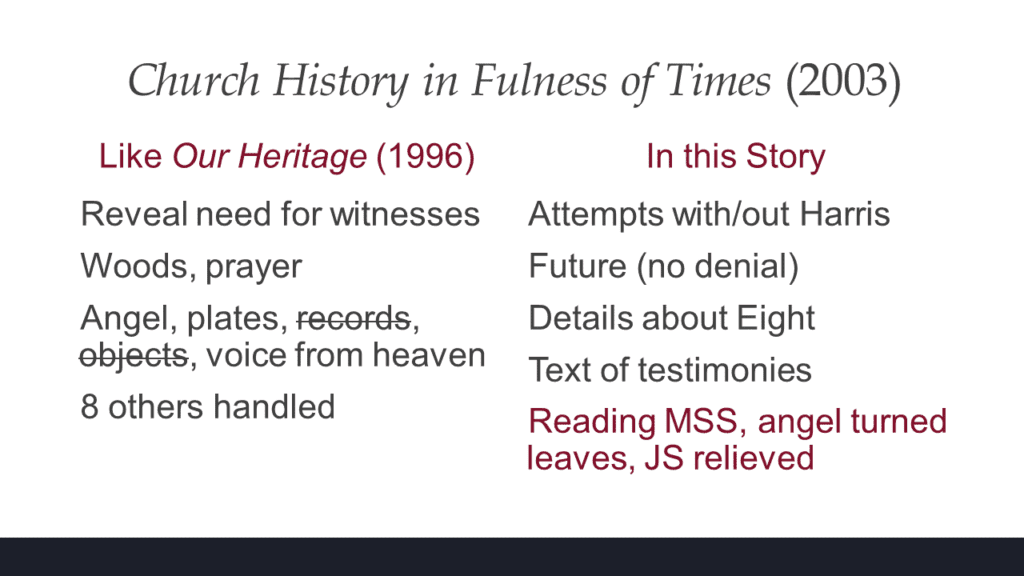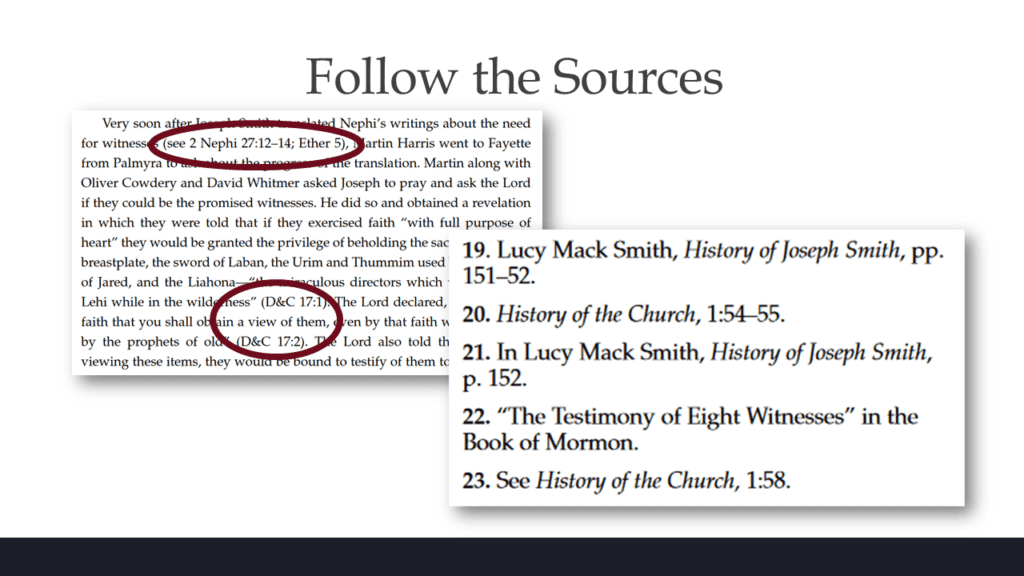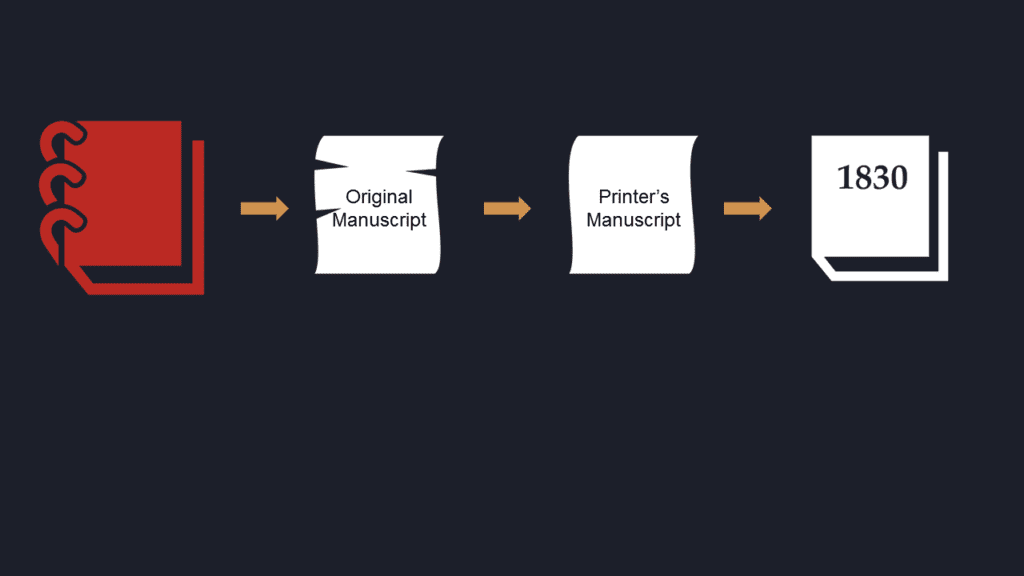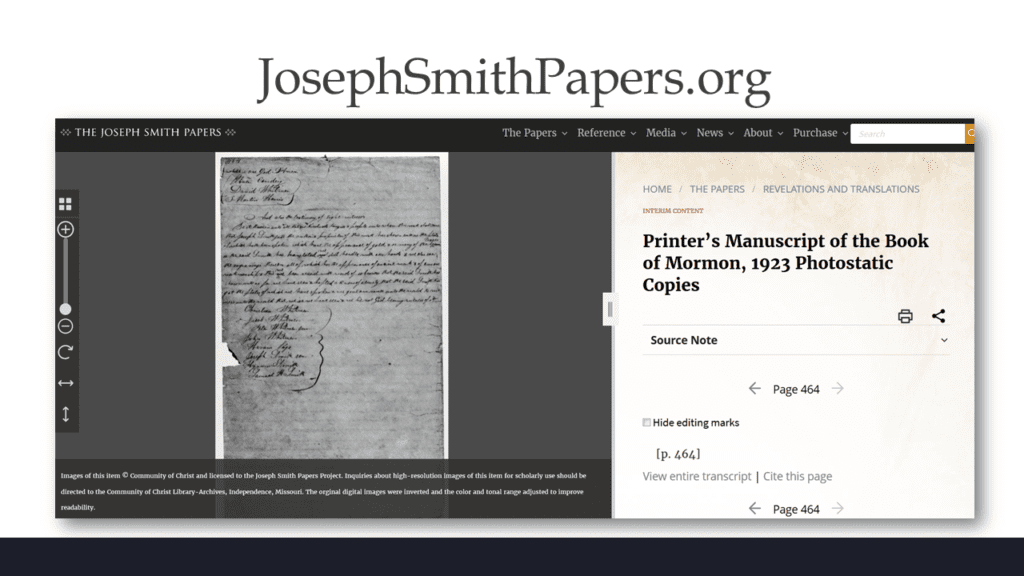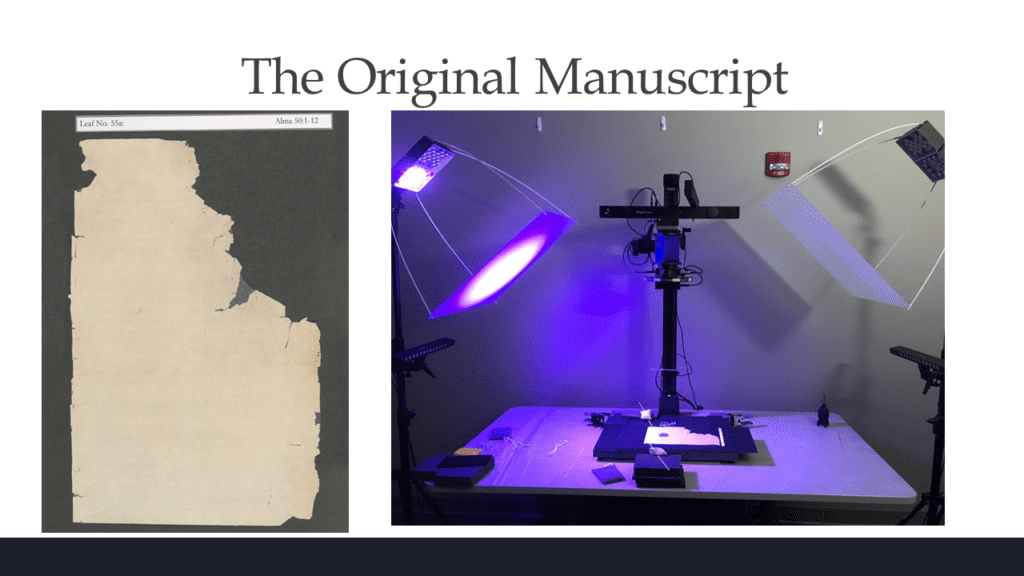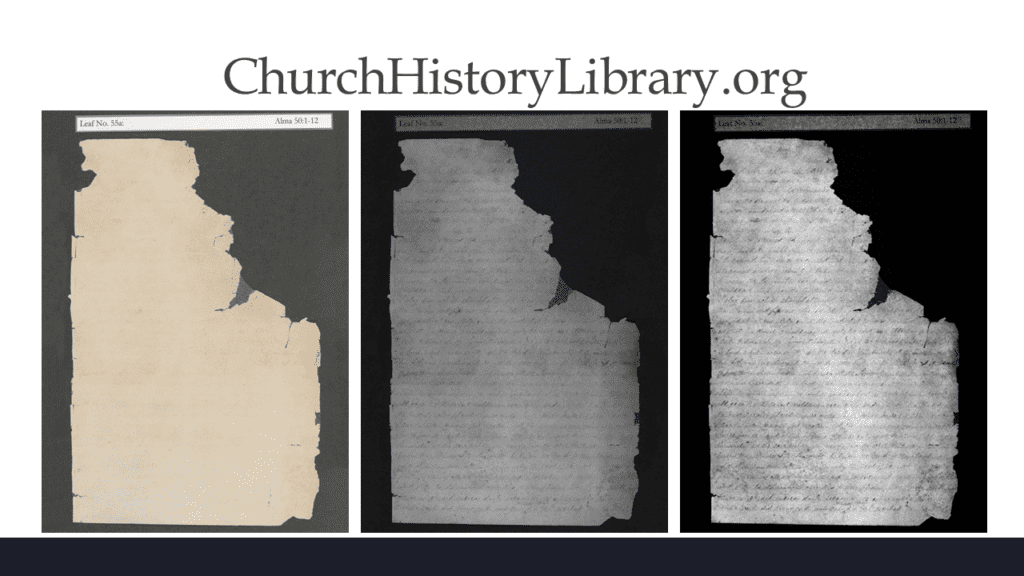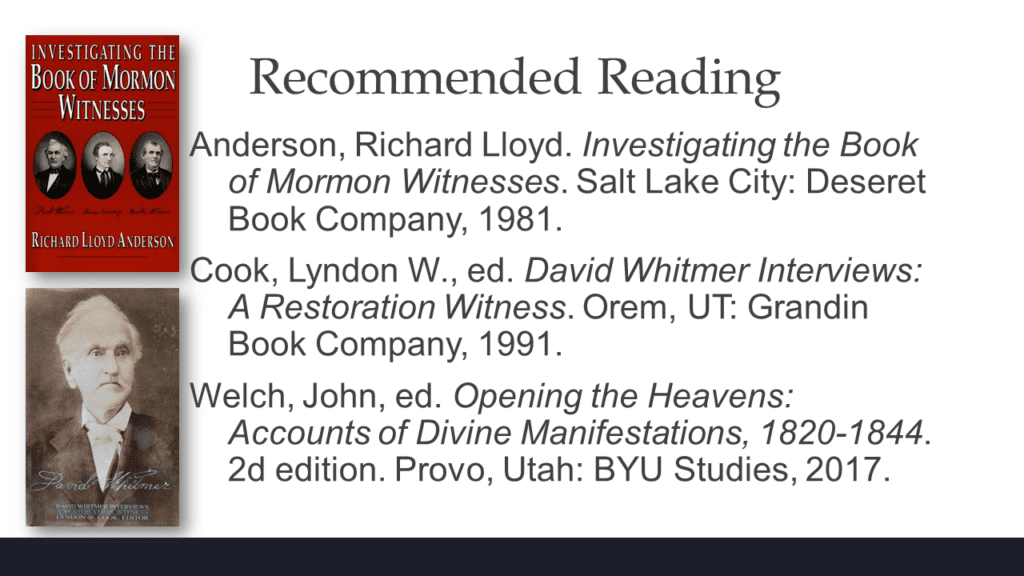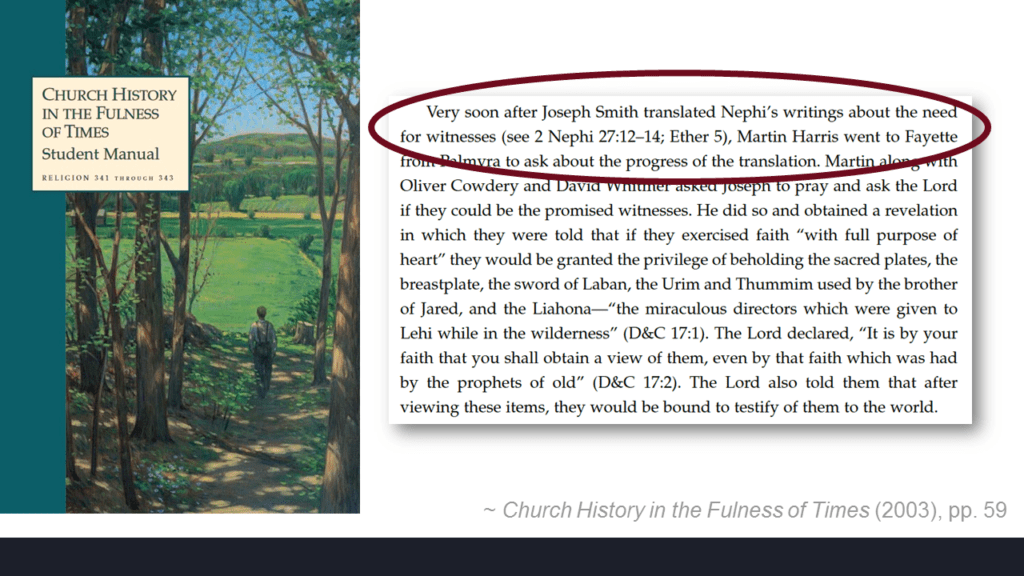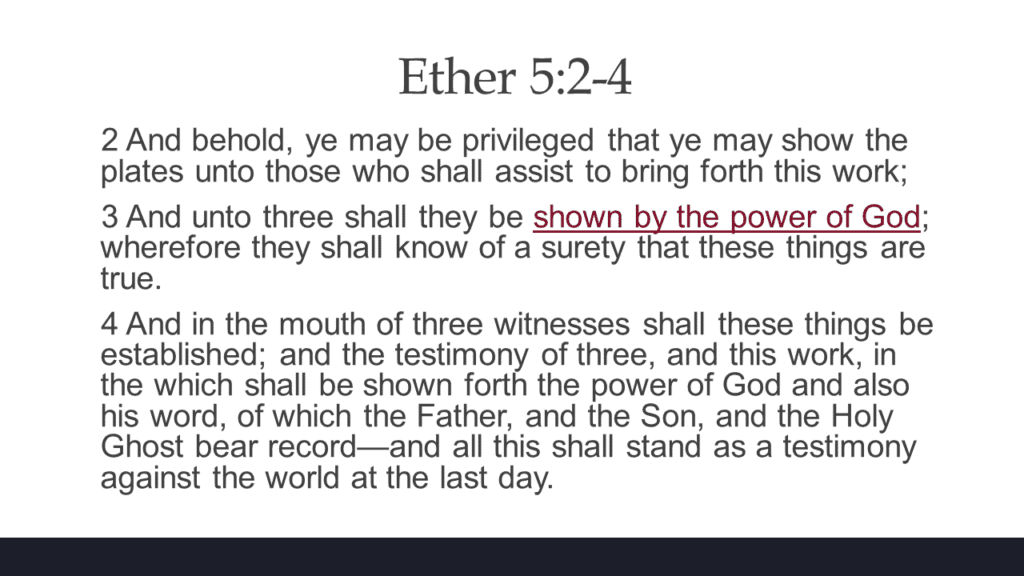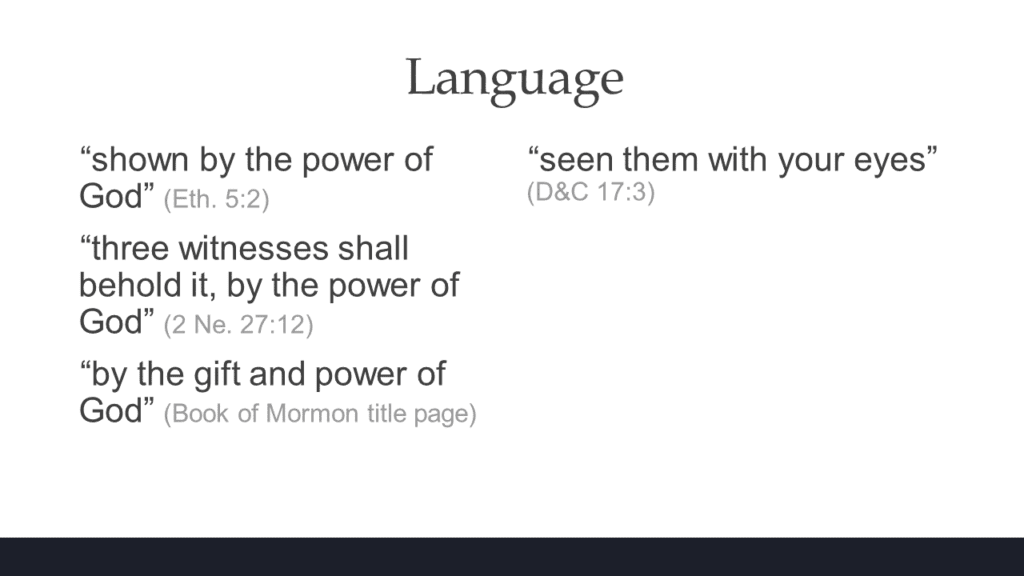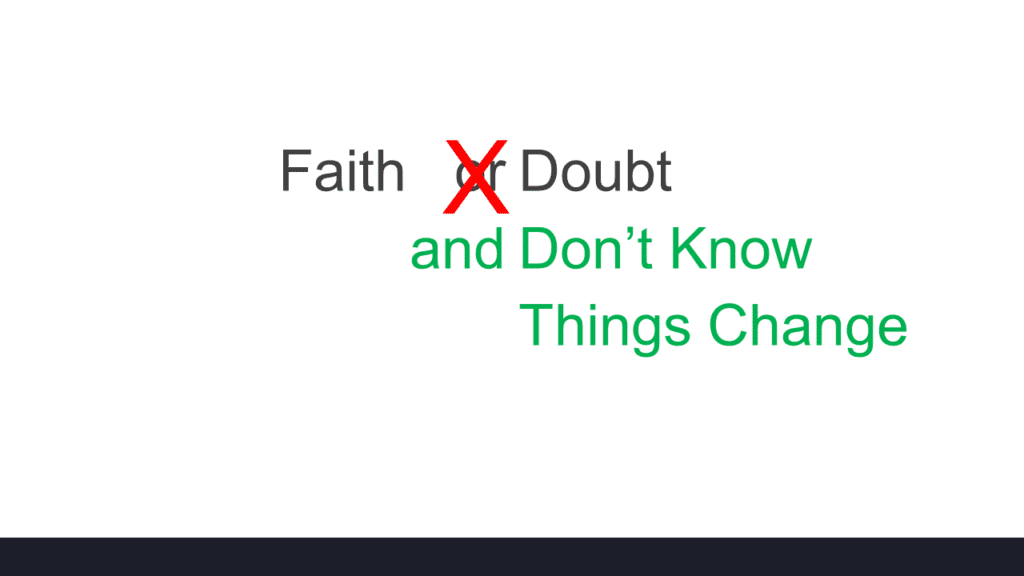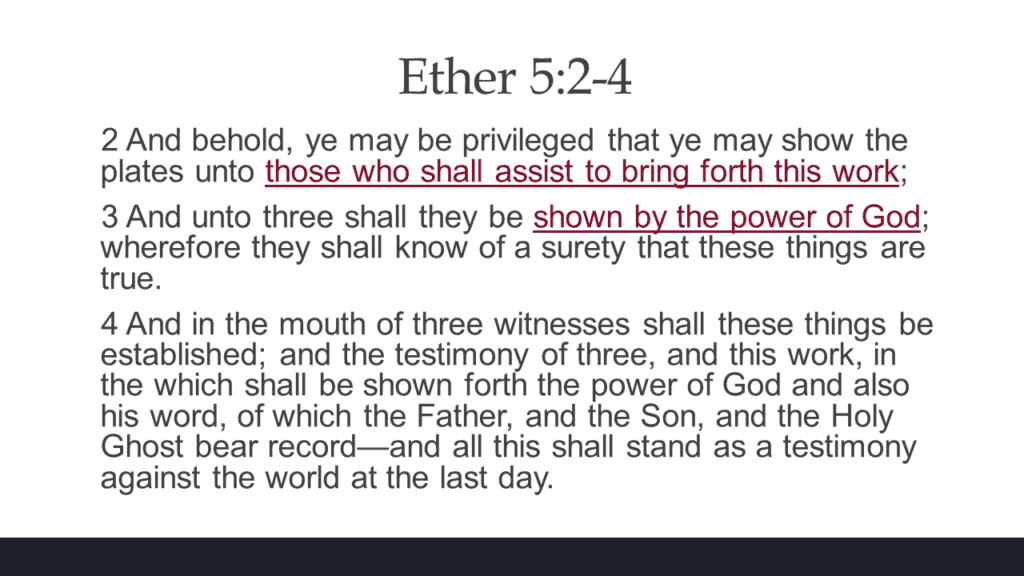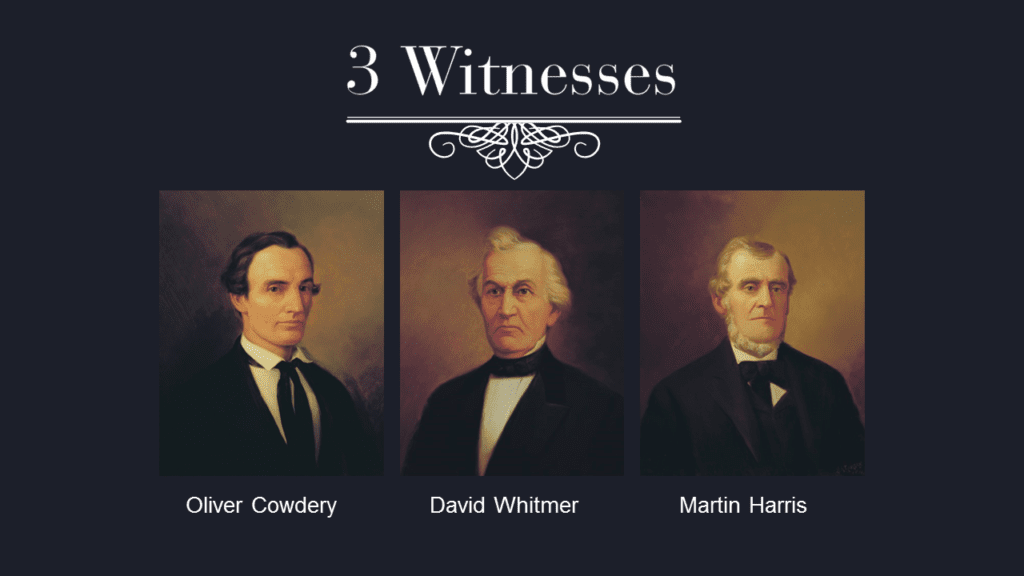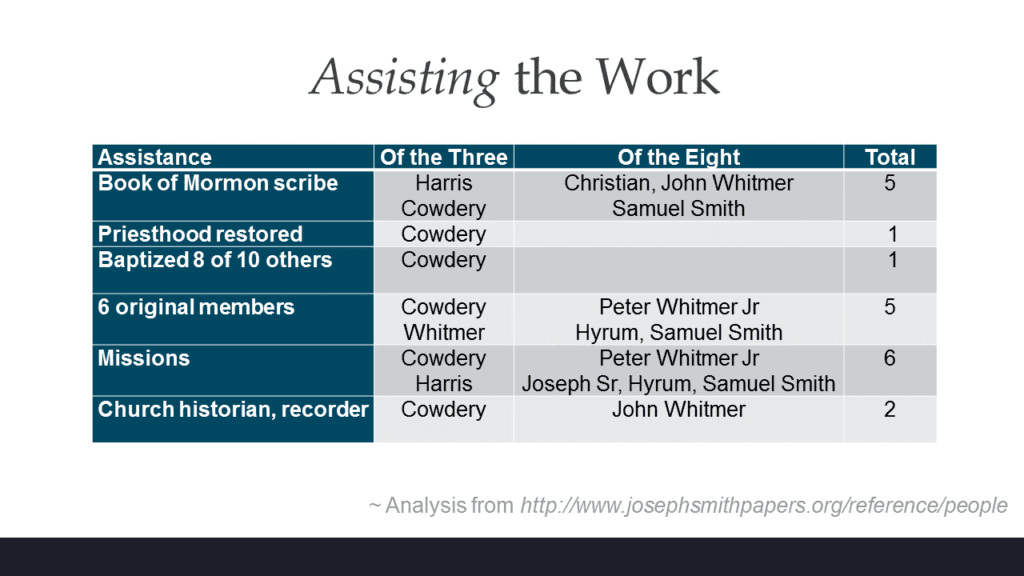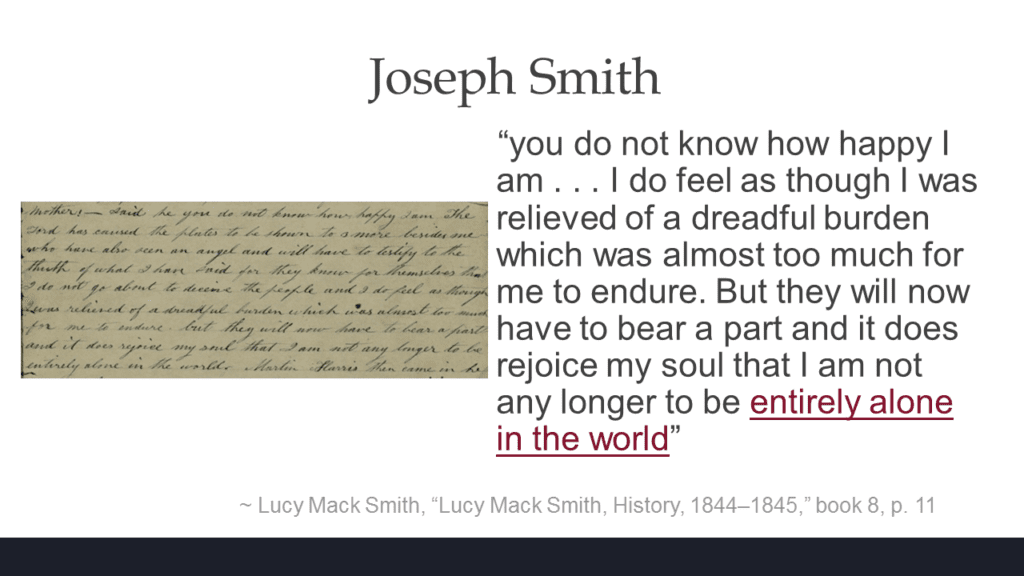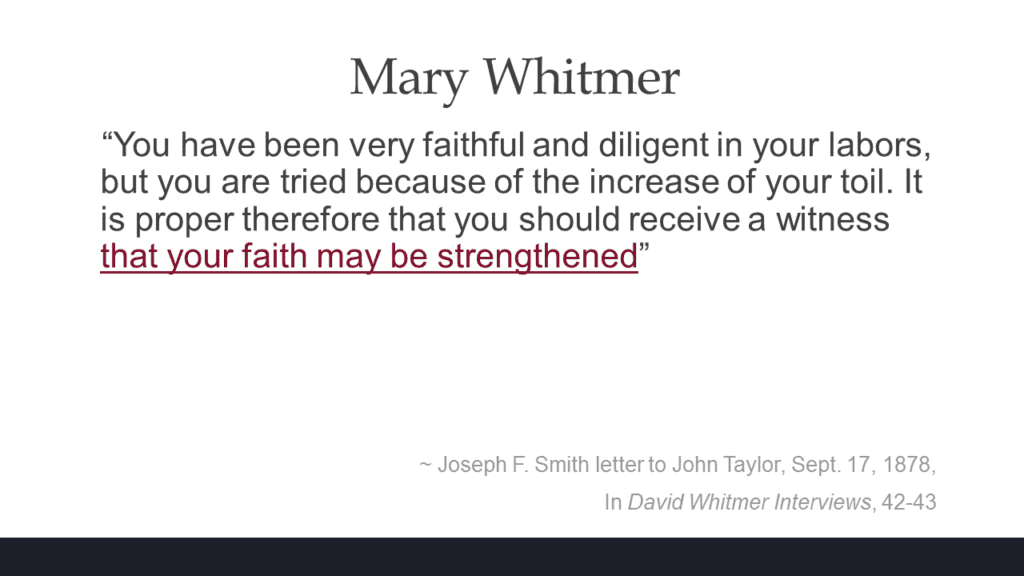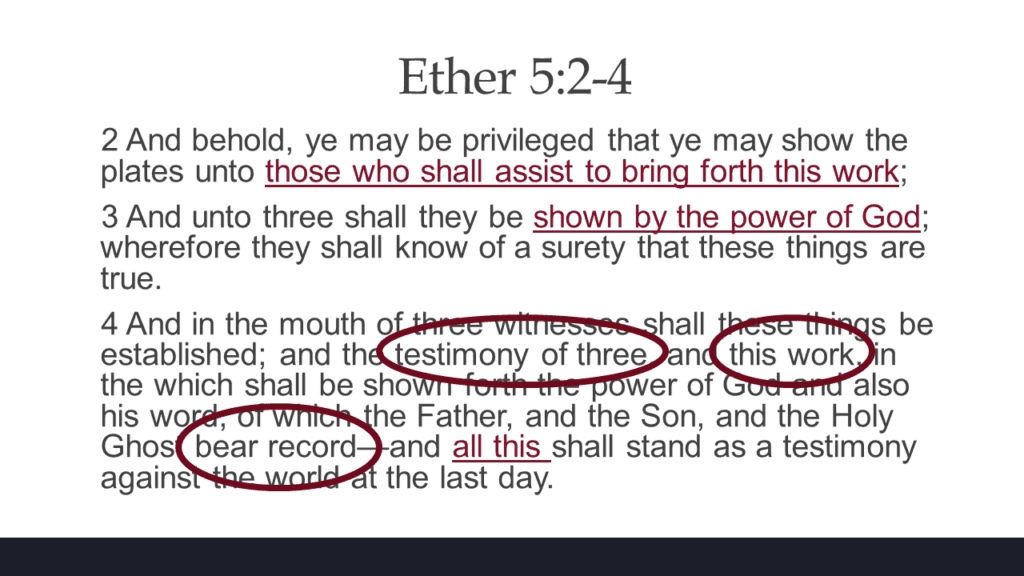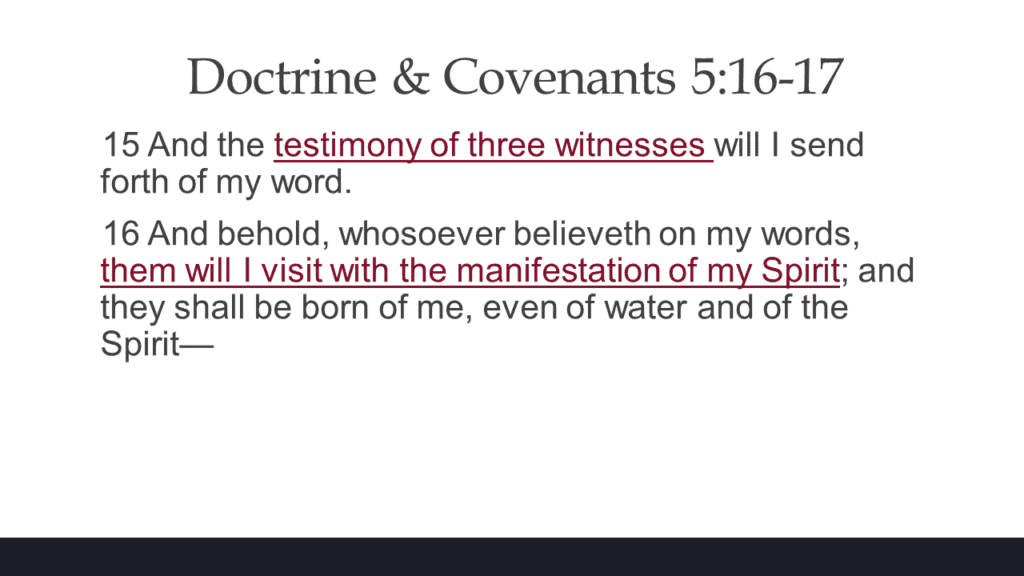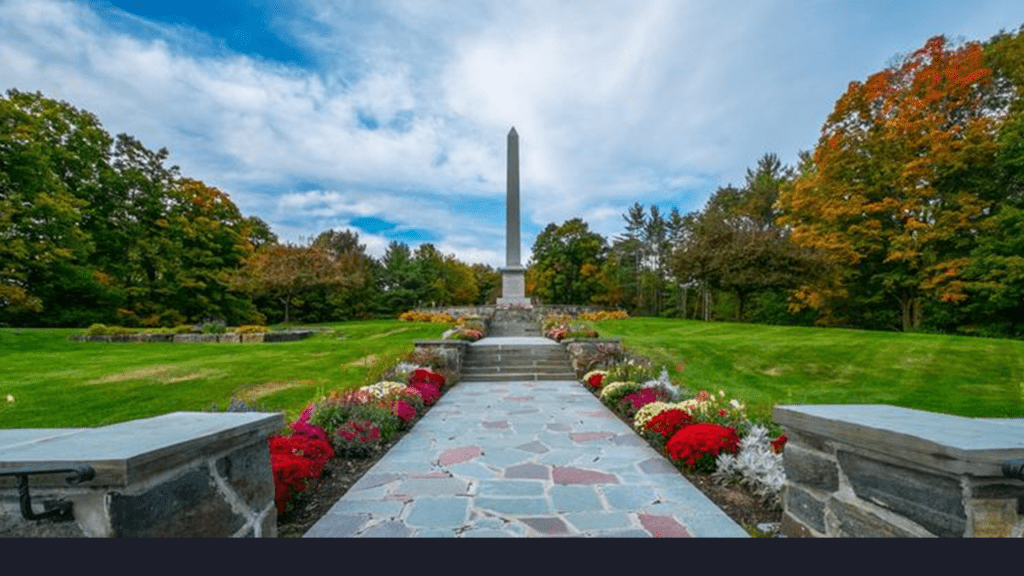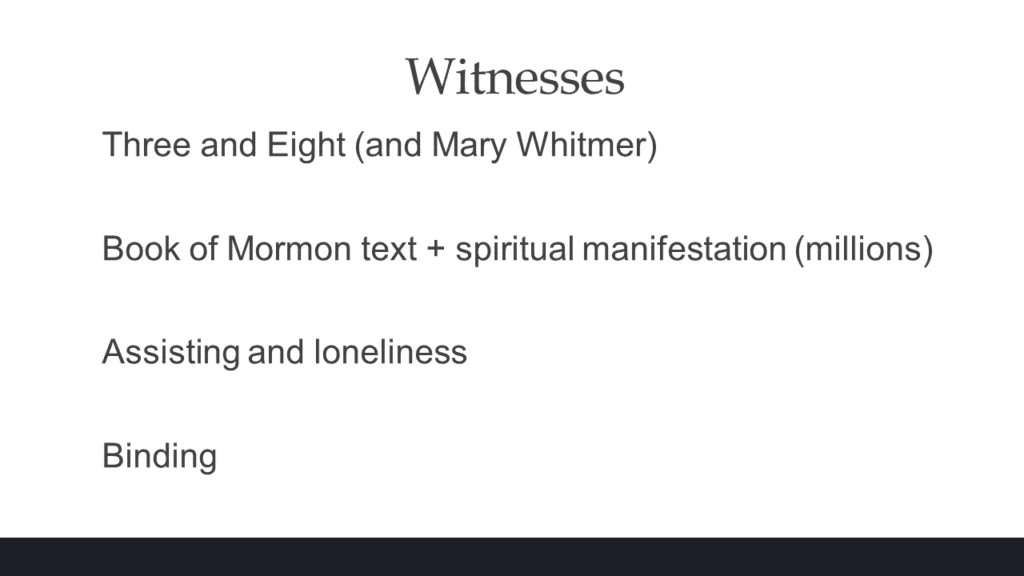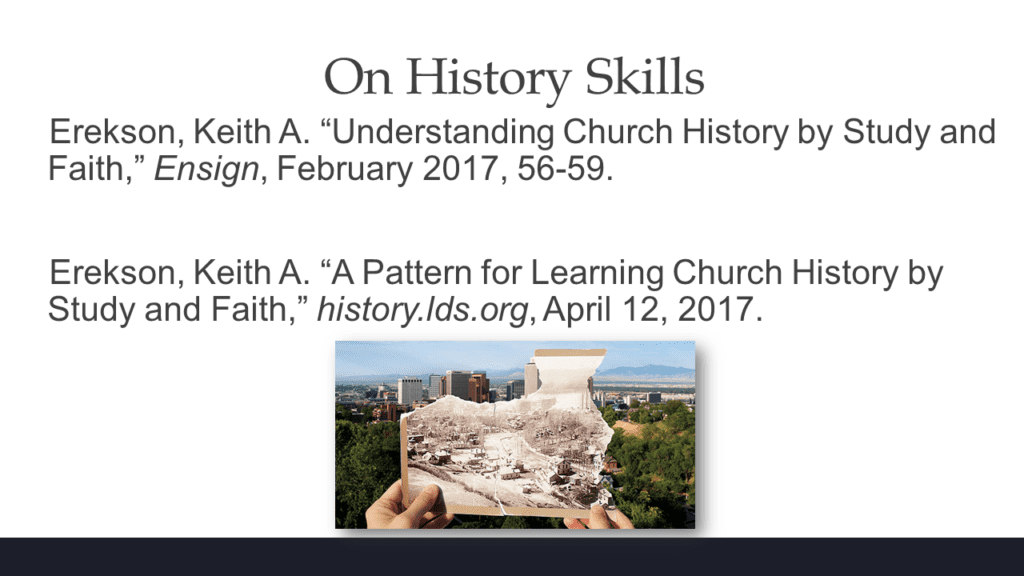Audio and Video Copyright © 2017 The Foundation for Apologetic Information and Research, Inc. Any reproduction or transcription of this material without prior express written permission is prohibited.

August 2017
Well, good morning! It’s nice to be with you today. I’m thankful to see you here. I’m thankful for the invitation to be with you today.
The question of the Book of Mormon witnesses is extremely significant. Several roles are defined in revelation. The Testimonies of the Three and Eight Witnesses were published in the first edition of The Book of Mormon and every edition since. As the Director of the Church History Library, where we hold the Church’s official archival, manuscript, and print collections, I have, sometimes, the opportunity to review the records of the witnesses, those that are relevant. But we also happen to have the world’s largest anti-Mormon collection and that’s because of [Doctrine and Covenants] section 123 – an instruction that counseled the early Saints to gather up libelous publications, magazines, encyclopedias, histories.[1] That’s a practice that we’ve continued through the twenty-first century. In those materials the witnesses come under quite a bit of scrutiny. From the earliest satirical newspaper accounts to Mark Twain, who, a little more whimsically, said, “I could not feel more satisfied if the entire Whitmer family had testified,”[2] to some of the more modern PDF documents that may or may not have been hastily cobbled together and placed on the internet.
So today this is what I’d like to do with this question of witnesses. I want to begin with a story, the story that we typically tell, and then I want to tug on the story a little bit. I want to pull on it. I want to see what we can see underneath. I want to use Church curriculum to do this. I want to use some antagonistic writings to do this. I would like to use some scripture to tug on the story that we think we know about the witnesses. Along the way I hope to demonstrate and articulate for you some skills—some history skills—that you can use to strengthen your study and your discipleship. I also hope that we can expand our view of witnesses and witnessing as we do this. So, let’s go for it. Let’s start with a story.
The Witnesses in Church Curriculum
This story comes from one of the books in Church curriculum, Our Heritage, published in 1996. This is the official companion to the Church History course of study for Gospel Doctrine. This is all that it says about the witnesses:
[Text on screen] While the Prophet Joseph Smith was in Fayette, the Lord revealed that Oliver Cowdery, David Whitmer, and Martin Harris were to be three special witnesses who would be permitted to see the gold plates (see 2 Nephi 27:12; Ether 5:2–4; D&C 17). They, along with Joseph, would be able to testify of the origin and truth of this ancient record.
David Whitmer explained: “We went out into the woods, near by, and sat down on a log and talked awhile. We then kneeled down and prayed. Joseph prayed. We then got up and sat on the log and were talking, when all at once a light came down from above us and encircled us for quite a little distance around; and the angel stood before us.” This angel was Moroni. David said that he “was dressed in white, and spoke and called me by name and said ‘Blessed is he that keepeth His commandments.’ A table was set before us and on it the records were placed. The Records of the Nephites, from which the Book of Mormon was translated, the brass plates, the Ball of Directors, the sword of Laban and other plates.” While the men were viewing these things, they heard a voice that said: “These plates have been revealed by the power of God, and they have been translated by the power of God. The translation of them which you have seen is correct, and I command you to bear record of what you now see and hear.”
Soon after this event, Joseph Smith showed the plates to eight additional witnesses, who handled them in a secluded setting near the Smith family home in Manchester, New York. The testimonies of both groups of witnesses are recorded at the beginning of the Book of Mormon.[3]
We have 300 words in this book. The book itself is about 150 pages. The witnesses get about three-quarters of a page.
As we talk about stories, it’s important to remember that the past is gone. In all of my storage vaults in the Church History Library I do not have the past. I do not have a spring day in 1820. I don’t have an afternoon when nine men walked into a forest. The past is gone. The people are dead. What I do have are pieces of the past, pieces that are left over. They’re in the form of stories. They are in the form of records. They are in the form of memories and reminiscences. But these stories are what we have to try and think about what happened in the past.[4]
So, if we take a quick look at this story we see a lot of things that we commonly talk about when we talk about the witnesses. We see a reference to the revelation of their [the witnesses’] existence. We see that David Whitmer, primarily, narrates the story. We see them going into the woods. We see that they prayed. We see that an angel came. The angel shows them records and other objects. We see that they heard a voice. And then it makes reference to eight other people who also handle the plates. And that’s the story. That’s the story that we get it the curriculum.
I don’t know if they told you, so I’ll warn you now: I want you to participate in this. I want you to talk to your neighbor; I hope you sat by someone smarter that you, so you learn. And if you didn’t, oh well; there’s another session next time. I want you to talk to your neighbor.
I’ve got listed here what we have in this story, but you’ve been around. You know there’s more to the story. What is not in this story? Talk to your neighbor for just a minute. [pause] OK, I wish we had the ability to let each one of you talk about how much smarter your neighbor was than you and what they told you.
I hope you said a couple of things in your conversation. I hope you said, “Oh, yeah, I remember they tried with Martin Harris and it didn’t work and then they separated and tried again.” I hope you noticed that in this story, in Our Heritage it didn’t say anything about the future, about them not denying their testimony. That’s often part of the story, the way we tell it. There also are no details about the eight witnesses, their story, their experience, it was just really quick. You saw eight people had a chance. And another interesting thing, we didn’t see the text of their testimony at all in that Our Heritage account.
I want to keep poking at this story though. I want talk about some sources. Another thing that you want to do as you read stories, as you hear stories, is ask: “Where is this coming from?” They cite a couple of scriptures here: Nephi, Ether, D&C 17. And then there are a couple of end notes. And if we pull up that portion of the text we see that the story is coming from two places. I’d like to take a look at each of these before we go forward.
Footnote 6 there is from the History of the Church. This publication [Our Heritage] is more than 20 years old. Today we can go one step better than the History of the Church. The Joseph Smith Papers is part of that project. We’ve published the manuscript of what became published and known as the History of the Church. We can go right here: this is in the hand writing of James Mulholland. We can see the quote and the story right in that earliest draft of the manuscript history:
[Text on screen] “These plates have been revealed by the power of God, and they have been translated by the power of God; the translation of them which you have seen is correct, and I command you to bear record of what you now see and hear.”[5]
Number 5 refers to a newspaper, The Saints’ Herald, published in 1882. To track this one down, I used the book that you see on the screen, the cover there, David Whitmer [Interviews].[6] This is a book that compiles all of his interviews. He did more than 70. David is the witness who most went on record with his testimony. They are compiled in this volume. What you see on the screen there, the open page, was an interview. It was published in the newspaper [in 1882, an interview by William H.] Kelly and [G. A.] Blakeslee. There are some interesting things in this interview. You can see, in the first place that I’ve underlined, that Whitmer is cautious. When these two show up and say, [paraphrasing] “Hey, we want to talk to you about your experience.” They report that he’s wary because he tells them that he just did an interview and [paraphrasing] “I told the reporter something and he went out and said I denied my testimony.” And so David Whitmer was kind of probing the interviewers and trying to feel, “Is this someone I want to tell my story to?” And then the second place that is underlined there, you may be able see that the interviewers—this is in the 1880s, so there is no audio recorder, there’s no video recorder—they are taking notes and they recognize their own inability to capture everything. Before they launch into the interview they say: [paraphrasing] “This is pretty nearly what David Whitmer said and we were happy to talk to him” and they tell the story. These are the two sources that we use in Our Heritage.
Not every author is as careful, not every interviewer is as careful with the sources. This is one of the things that you want to look for. This [on screen] is a page from Fawn Brodie’s No Man Knows My History.[7] This is the part where she’s talking about the witnesses and right here she mentions, this is how she frames it–“David Whitmer told the editor of The Reflector”–and then there’s a description that follows. But if we are thinking about this, this is the way it’s presented in the text. Fawn Brodie is quoting the editor, and David Whitmer told the editor. One the benefits I have in the Church History Library is we have these things lying around in our storage vaults. So I called out The [Palmyra] Reflector from the date that Fawn Brodie cited to take a look at it.[8] When we zero in here on this paragraph something interesting comes out. The witness described the book and then the writer says, “our informant did not recollect precisely.” So what’s missing here is there was an informant in between the editor and David Whitmer, and the editor is telling us, “The informant didn’t recollect precisely.” I am going to tell you about one other thing about The Reflector. Many of the pieces in The Reflector were satirical. It was a newspaper, so it was not quite like The Onion today where everything is satire, but you would get the stories in here–and this device of having the shadowy informant who may or may not remember everything particularly–that is a literary device that works well in satire because you tell a story, you attribute it somewhere fuzzy, and then you’re off. One of the things to say here is that we want to drill down and find the sources underneath the stories that we are telling.
Here is the single best study of the witnesses and their testimony. If you want to read only one thing, I would recommend this book [Investigating the Book of Mormon Witnesses] by Richard Anderson. Here is one of his conclusions after looking at all of the testimonies. He says, “A main safeguard exists for testing the claims that a witness modified his testimony—be sure that all statements come from the witness himself.”[9]
We already mentioned that David Whitmer provided more than 70 statements. Taken collectively, the witnesses have provided more than 200 first-person accounts of their experience and testimony being witnesses. Sometimes in history we have no records and so we’re groping around. Is there maybe report in a newspaper here? Is there another piece there? And we put them together and come to some conclusion. In the case of the witnesses we don’t have that problem. Our problem is we have so many testimonies
One of the smell tests, if you’re reading something, and you see it’s quoting a person fourth hand or second hand. Or another tell-tail sign, if it’s not very clear, actually, where they’re quoting from, your reaction needs to be: “I know there are more than 200 statements from the witnesses. I want to see those before I start figuring out where I got all of these other things from.”
So that’s our starting story. Now I want to start to tug on it a little bit. I want to share another story as we move forward with the question of the witnesses. This story comes from the Institute manual, Church History in the Fulness of Times. Here we have 1,200 words, four times as much space devoted to the witnesses.[10] A real quick summary, just like Our Heritage, it talks about the things that we’ve seen. Although it doesn’t talk about them [the Three Witnesses] seeing other records like the brass plates or objects like the Liahona, there are some things that are in this story–the things that we just talked about a few minutes ago about not being in Our Heritage–are in this manual. We talk about the attempts with Martin Harris. They talk about the future story of the witnesses: that five of them died active in the Church; six fell away; two returned. They talk in detail about the eight witnesses. There is actually a table in there that identifies each of the witnesses, when they were born and has facts about them. And it contains the text of the testimony of the witnesses, a sample from the text. And then there are a few other things that you may also have mentioned as you were talking to your neighbor. It talks about Joseph reading the manuscript of The Book of Mormon before they, the Three Witnesses, went out. It talks about the angel in the Three Witness’ experience turning the leaves of the plates and showing them to the Three Witnesses. And then there’s a passage about Joseph being extremely relieved when all of the witness experiences were done. All three of those experiences come from the writings of Lucy Smith.
Now in the same way we want to follow the sources here. You’ll see that it quotes, actually, the same three scriptures: Nephi, Ether, Doctrine & Covenants 17. We see Lucy Smith features prominently in the notes; The History of the Church, that narrative that we’ve seen is also there; and testimony of the witnesses.
Sourcing the Testimony of the Witnesses
Now I want to dig in on the testimony of the witnesses for just a moment here about where it came from. On the screen there’s a diagram of a couple of different manifestations of the text of The Book of Mormon. On the far [right] side is the 1830 edition. We know the testimony of the witnesses was published there for the first time. On the other side you see the gold plates, or I guess they look kind of like red plates today [on the slide]. (Sorry about that!) You see the plates. Was the testimony of the witnesses on the plates? No, obviously not. They are not part of that record. It contains instruction to get witnesses. So they are not there. So we have the question then: “Where does the testimony enter the stream of the text?”
When Joseph translates from the plates he dictates and the scribes write what we’ve come to call today the Original Manuscript. Then Joseph instructed Oliver Cowdery to make a copy of the original manuscript. He’d learned, from the 116 pages incident, to have a copy. The copy, that second one, is what went to the printer for the printing. That one has become known as the Printer’s Manuscript.[11]
Where does the testimony of the three witnesses enter the story? Well, the Printer’s Manuscript has been preserved in the archive of the Community of Christ. It was recently published as part of the Joseph Smith Papers.[12] We can see in Oliver’s copy of the manuscript there is copy of the witness testimony. This is in Oliver’s handwriting.[13] It’s consistent with the rest of the manuscript. He copied the entire manuscript and copied in the testimony of the witnesses. So that brings us back to the question: “What was the earliest draft of the testimony? Did they actually write it on the original manuscript? Or, did they write it down somewhere else?”
We know they write it down because Joseph Smith, in his histories, prefaces the testimony by saying the witnesses “drew up and subscribed the following document.”[14] In one of his later accounts, David Whitmer said that each of them signed his own name to the document.[15] So the question is “Where’s that document? Where are their signatures?” If there is another extra document that was the first draft, we haven’t found it. We don’t know that it exists anywhere. That’s one if you’re cleaning your attic and you find it, let me know. The Original Manuscript would be the other theory. Maybe as they were dictating that they just wrote it right there.
The Original Manuscript has its own set of challenges; they begin in its own history. When the Saints lived in Nauvoo, Joseph put the original manuscript in the cornerstone of the Nauvoo House and then the Saints moved west. Fifty years later or so they open up the cornerstone; water had gotten in; the manuscript suffered extensive damage. Our best estimates today are that only twenty-eight percent of the manuscript survived. About half of it is in the Church History Library, the rest are in other locations. But I want to tell you about something cool about this document.
The pieces that survive—and they look kind of like this, torn, soggy; I mean they’ve dried out in the years since the 1880s, but they were very damaged—we have begun a process downstairs, our preservation division in the Library, of using multi-spectral imaging to take photographs of the manuscript pieces. All of pieces that are not in the Library’s collection have been loaned to us in recent months to do this. We can take more than two dozen photographs with different light on the spectrum from infra-red to ultra-violet and visible light. We can take the document that you see on the screen there, and we can do something like this at one spectrum of light, and reveal text that you can’t see to the visible eye. Then we’ll take the variety of different spectra that we can use, and we’ll put them into a composite version that gives the best reading of the document. Now, you know what this page happens to say? “And in came to pass…” OK? No. [laughter] Many of the pages say that.
The preservation work has been going on this year. They’ll be published as part of the Joseph Smith Papers in a few years from now. We are trying to figure out just exactly, we want to publish original photographs so you can see what they look like. We want to publish the best composite that gives you the best chance of reading it. And we’re trying to figure out ways to share–most likely it’ll be online–different light spectra that you can kind of play with yourself.
If you want to know more about this, I am happy to say that the Library has just started a blog called The Historical Record, and we’ve just posted an article about this photographic process[16] and we’re really excited, over the next couple of years, as we work this together and bring it forward. Everything we know from the original manuscript of The Book of Mormon will be published there.
We’ve picked up a couple of skills as we’ve done these stories and played with the stories:
- We’ve done some really close reading. We are analyzing; we are looking at multiple accounts; we are corroborating what we find.
- We’re following the sources. And one of the things you want to do is expect citations. There are publishers—I won’t name them—who will publish things without citations. That’s the first sign. If they don’t even care enough to tell you where they found their historical information, don’t worry about spending the time figuring out if they’ve made it up or if they haven’t. That’s going to be one of your first tests. I expect to see citations and I expect to see them be good if this is someone who wants to be convincing me of something about history.
Along the way we’ve talked about a couple of these books, Richard Anderson’s book, Lyndon Cook edited the David Whitmer Interviews. There’s another one that BYU Studies put out called Opening the Heavens where many of the witness testimonies are included in that volume as part of their discussion of their experience.[17]
Using the Book of Mormon to Understand the Witnesses
I’m not done tugging on this story and I want to tug on it now from the standpoint of scripture. Many distinguished commentators in recent years, including Ezra Taft Benson, Grant Hardy, Terryl Givens, have urged people to take The Book of Mormon more seriously.[18] Many times people interpret that to mean “I’m going to read it,” or “I’ll read it again”. Today, I want to interpret that by using The Book of Mormon to poke at our stories of the witnesses, because I don’t think we’ve really understood everything that we need to understand. And I think that The Book of Mormon turns out to be a place that points to some things that we should have been paying attention to that we haven’t.
Back in the Institute manual you see that it makes reference to Nephi, Nephi’s writing. But I want to look at another one. It’s cited both times, but not called out. This is a passage from the book of Ether [5:2-4]. Our best understanding of the way the translation unfolded was that when Oliver Cowdery arrived in the spring of 1829, he and Joseph picked up right where they left off after the 116 pages. So they picked up in Mosiah, translated to the end of the text, and then they found the small plates and translated there, and then those were attached at the front of the story. So Ether in that scenario–this passage in Ether–was the first one Joseph encountered telling him about witnesses. And then when they got to second Nephi it would have been a second place to talk about this. So this passage is interesting. And I want to look at a couple of the phrases piece by piece.
First is this one, that I just highlighted, that says that the experience will be “shown” to the witnesses “by the power of God” [Ether 5:3]. Talk to your neighbor again. (I hope your neighbor isn’t asleep. Poke your neighbor.) Here’s what I want you to talk about: Where have you heard that language before—“shown by the power of God”—where have you heard it? In Church History, in scripture, that’s the wording. Where have you heard it? [pause]
OK, I didn’t hear quite as much talking about this one as we did the first time. Was this one tougher? Well, let me give you a few places that I’ve seen it. The first one on the screen is the passage in Ether. Similar language comes back again in second Nephi in that passage [2 Nephi 27:12]. Similar language appears on the title page of the Book of Mormon: that it was translated by the gift and power of God. It turns out that every time Joseph was asked in his life, “How did you translate the plates?” this is the type of language he used. We don’t have a single statement from Joseph where he said “I had a seer stone, I had a hat, I did this, it was morning, it was afternoon.” It’s the scribes who give us that kind of detail. There was even a conference in 1831 where Hyrum kind of nudges Joseph to the floor and says, [paraphrasing] “Tell us how the book was translated,” and Joseph says it was translated “by the gift and power of God.”[19] This phrase, I think, is a really important phrase as we think about the translation and the witness experience.
So I want to ask another question. This is going to be a little harder. What is not in that language? It’s always easy to ask “What do you see on the screen?” But, now I want you to think about every other context you can think about witnesses, testimonies. What’s not part of this language? Well, let me give you a couple of examples.
One thing I don’t see here in the passage—in the language, in the way that it’s used—I don’t see the invocation of legal rhetoric. We know Joseph cared about the law because when it came time to copyright The Book of Mormon he went in, he filed for the copyright, he knew about the law. He knew how legal proceedings work. When it came time to organize the Church we again hear Joseph talking about “…according to the laws of New York.” When we talk about witnesses we don’t have language like, “Well, you need to have an affidavit, and you need to have the constable sitting there.” Any of the legal language, I don’t see in this passage.
There’s some other language that Joseph uses later. By the time they are in Nauvoo, we see this in [Doctrine and Covenants] section 127, 128, when they’re talking about baptisms for the dead, there is language that emerges about eye-witnesses and certifying what was happening and conveying that record to the central record place. So we don’t see either of those–the legal language or the temple language of eye-witnesses in certification–in these descriptions of what the witnesses were supposed to do.
A couple of skills we’ve been working on right here:
- We’ve been asking some questions. We asked a connecting question: “Where did you see that language?” And then we asked a comparison question: “What’s not here?” Compare it to other things you know. “What don’t you see?”
- And those lead us to probably one of the most important skills that we need when we understand anything from history is to avoid present assumptions. If I walk into a discussion about the Three Witnesses and I assume this was a legal proceeding–therefore, there’s is going to be judge and a record and a signed affidavit–I am going to turn out really frustrated and sad because, darn it, those 200 year-old people weren’t behaving the way that we behave in twenty-first century America? How could they not do that?
So, we’ve got to be aware of the present assumptions that we inflict on the past, because we do damage to the past when we do that. Here’s one other assumption that we inflict from the 21st century. We find it in some other passages. Doctrine & Covenants 17 talks about seeing with your eyes. I talk to so many people in the 21st century–and by the way, I’ve not talked to anyone from the 19th century, just so you know–but, in the 21st century, as I talk to people, this is often a challenge. They ask me, “Well, did they see it with their eyes or was it a vision?” And one of the things that is going on there, it’s un-stated, but it is a modern assumption and, frankly, we do this all the time in Church discourse. We have set up our conversation. We’ve forced it into a dichotomy. There are only two things–either they saw it with their eyes, or they saw it in a vision–and it can’t be both. We do this all the time. A lot of times, when people are talking to me about a faith crisis, the language goes like this, “Well, I used to have faith and now I have doubt.” You see, the common underlying assumption is that there are only two things that I can have. And if I start to have one, doubt, then I must stop having the other one, faith. That’s something that we’re bringing from the 21st century. That’s something that we want to shed. I would encourage you to replace the “or” with an “and.” That’s going to feel weird to you and maybe some of your friends—“No, I can’t have faith and doubt at the same time!”–of course you can! The scriptures are full of stories of people who have faith and doubt at the same time. Why have we in the 21st century said, “No, it’s either all faith or it’s all doubt, there’s nowhere in between”?
My favorite story that illustrates this is in the New Testament when a father brings his sick child to Jesus and asks Jesus to heal the child. And Jesus says, “I can, if you’d believe,” and the father says, “Lord, I believe. Help thou mine unbelief” [Mark 9:24]. Can you imagine confessing to Jesus face to face that you have faith and doubt at the same time? Oh, you’re in for a big scolding, right! Of course not. What did the Savior do? He healed the son. And, I believe, along the way, He strengthened the “unbelief” part of that father.
It’s OK to have faith and doubt. When we add doubt we can add other things. We can add, “I don’t know.” That’s a valid answer. The past is gone. There are lots of things we don’t know. We can add, “Things change.”
So, I want to break away from the present assumptions that we take. I want to go back to another passage in this text from Ether. It’s the one in verse two that’s underlined, “those who shall assist to bring forth this work” [Ether 5:2]. One of the things that strikes me when we talk about the witnesses, we focus a lot on their witness experience. We’ve just narrated that experience. And then sometimes we talk about what happened later. But have you ever asked the question, “How did they assist in this work?” Well, among the three witnesses, two of them served as scribes while Joseph was dictating the text of The Book of Mormon. David Whitmer provided a place, his home, for the translation, and Martin Harris provided money. Oliver Cowdery participated in the restoration of the priesthood. He baptized eight of the other ten witnesses. Joseph baptized David Whitmer and his brother, Hyrum. The rest of the witnesses were baptized by Oliver. Oliver served–this one may be less interesting to you and more to me–Oliver served as the first recorder of the Church. He held that official position as Church Recorder.
When we consider all eleven of the witnesses, we see five served as scribes. We have five of the six members at the day the Church was organized, the sixth being Joseph. We see six who went on to serve as missionaries. In addition to the first Church Recorder we also see the first Church Historian. So yes, they assisted in this work in many, many ways. But, assisting is an interesting word. There’s a two-way relationship applied to assisting, right? Somebody, the witnesses, are assisting, but someone else is being assisted. Who is it that needed help? Who is it that felt alone?
This is one of the details that Lucy Smith adds to our story. After the witness experience ends, she reported that Joseph came back and said to her and others, “You do not know how happy I am . . . I do feel as though I was relieved of a dreadful burden which was almost too much for me to endure. But they will now have to bear a part of it. And it does rejoice my soul that I am not any longer to be entirely alone in the world.”[20] That’s really sad language right there–“entirely alone in the world.” How long had long had Joseph been feeling that? “…entirely alone in the world.” I wonder if that loneliness extended beyond the world. You know, the passage in Ether was written by whom? Moroni. This is one of the interventions where Moroni is translating and he writes this passage to the witnesses. Moroni is an interesting expert on loneliness. He witnessed the destruction of his people. He finished his father’s record. He experienced loneliness. He wrote about it [Moroni 1]. He translated the plates of Ether and attached them. He sealed them up with the interpreters. He held the “keys of the record of the stick of Ephraim” [D&C 27:5] and for centuries prophets had prayed that these records would be preserved–and they had been–right to that moment that Moroni had them. And those same prophets prayed that the records would come forth, which depended entirely upon him.
In order to succeed, Moroni appeared in the 19th century at least twenty-three different times.[21] I think Moroni was anxious about making sure this whole thing got handed off and turned out right. And that relief—this is me imagining how angels feel; I have no experience so maybe he didn’t feel any relief at all, but I would imagine he was feeling relieved—after centuries of work this has been handed off and it’s gone where it was supposed to go.
One of Moroni’s appearances that we’ve talked about here provides one more twist on this question of assisting and loneliness. I’ve talked for a few minutes about the way that the formal witnesses assisted and I talked about formal roles: callings, positions, missions, things like that. But, while David Whitmer invited Joseph to come to his home and translate The Book of Mormon here, what that meant in real life for David Whitmer’s [mother], Mary, was more work. Joseph came, Oliver came, Emma came, visitors came, in and out, in and out, larger meals, smaller meals, more to clean, more to do. And so, one night, as Mary Whitmer walked, alone, from her house chores out to her milking, Moroni appeared to her and showed her the plates. And he said, (through stories that the Whitmer family reported, this particular one was on a fact-finding mission to Joseph F. Smith) they reported–and we have three different account of this, so I have chosen one–that Moroni says to Mary Whitmer, “You have been very faithful and diligent in your labors, but you are tried because of the increase of your toil. It is proper, therefore, that you should receive a witness, that your faith may be strengthened.”[22]
So, using our comparison tools, we’ll step back. The men, to be witnesses, they prepared, they went to the woods, they prayed, they repented. Mary kept house, did chores, milked cows, cared for guests. The men were given a witness to share with the world. Mary was given a witness to strengthen her personal faith. Clearly, Moroni, who understood a thing or two about loneliness, had a larger view of what it means to assist in this work.
OK, one more passage right here at the end that I want to look at, is these two words right at the bottom, “all this” [Ether 5:4]. (They are underlined.) “All this”, I think, are two words that we’ve missed when we talk about the story of the witnesses. Now we’ve got to back in the sentence to see what we are talking about. We see that it’s talking about the “testimony of the three” witnesses. It’s also talking about “this work”–the book, The Book of Mormon. So their testimony, the book itself–and the book will show the power of God and His word. And then there is another clause, “of which the Father, the Son, and the Holy Ghost, bear record.” So there is a third thing–“all this, which will stand as a testimony” includes three parts: the testimony of the witnesses, the book itself, and then a record that is promised.
So the story of the witnesses can’t end with their experience, it also can’t end with their deaths, to say that they didn’t deny it. It must continue to include this record that’s borne of God.
One of the sections that talk about the witnesses that we don’t see in the footnotes of any of the curriculum that we’ve looked at, is in [Doctrine and Covenants] section 5. It talks about the testimony of the three witnesses, “will go forth and whosoever believeth on my words, them will I visit with a manifestation of my Spirit” [verses 16-17]. So there’s a promise, not just that the testimony will go forth, but there’s a manifestation that is going to follow it–and come to those who ask for it.
I think the most beautiful place I have ever seen this part of the story illustrated is on monument at the birthplace of Joseph Smith in Vermont. The monument was erected in 1905, long after the witnesses were dead. It was on the 100-year anniversary of Joseph’s birth. But, on the side of the monument there is some text, that is reproduced on the screen:
In the spring of the year of our Lord, 1820, The Father and The Son appeared to him in a glorious vision, called him by name and instructed him.
Thereafter heavenly angels visited him and revealed the ordinances of the Gospel, restored the authority of the Holy Priesthood, and the organization of the Church of Jesus Christ in its fulness and perfection.
The engraved plates of the Book of Mormon were given him by the angel Moroni. These he translated by the gift and power of God.
He organized the Church of Jesus Christ of Latter-day Saint on the sixth day of April, 1830, with six members.
He devoted his life to the establishment of this Church, and sealed his testimony with his blood.
In his ministry he was constantly supported by his brother Hyrum Smith, who suffered martyrdom with him.
Over a million converts to this testimony have been made throughout the world; and this monument has been erected in his honor, to commemorate the one hundredth anniversary of his birth, by members of the Church which he organized.
They love and revere him as a Prophet of God, and call his name blessed forever and ever, Amen.
The title of the text is Testimony of Joseph Smith, and as you read through the first paragraph you see the spring of 1820. In the second paragraph you see angels. You see the plates. Going down, you see the Church organized, you see Joseph’s death. And then, there is an interesting phrase that just jumped right out to me. In 1905 they inscribed on this monument “Over a million converts to this testimony have been made throughout the world.” Now, those of you who have your Church almanac in your lap are going to say – now wait a minute, the Church didn’t reach one million members until 1947. It was kind of exciting, centennial of the pioneers and we reached a million members. Well, those are a million living members at a single time. When we talk today about there being 16 million members of the Church, we are talking about living people. What he inscribed on the monument is–since 1830 over a million people, many of whom are now dead, are converts to this testimony. So the inscription on this monument is not a testimony by Joseph, it’s a testimony about Joseph–by us, who visit the site, who think about the work. It’s a testimony that includes the three and the eight. It includes the roughly 15,000 Saints who were living at the time of Joseph’s death. It includes the 16 million who are alive today. It includes prophets and apostles. It includes members who are female and male, black and white, Republican and Democrat, quarterbacks and Motown singers, businessmen, and you and me. We are part of this collective witness. Joseph walked out of the grove. He has passed on. But, God is not dead! One of the things that we can ask is, “What were you doing on a spring day in 1820?” That’s what God is promising here. The testimony will go forth and it will be followed by a manifestation by those who ask for it. This manifestation comes as a kind of reinforcement.
Joseph Fielding Smith described it this way in Essentials in Church History, a volume that was in print for more than half a century, “Reinforced as that testimony (Joseph’s testimony) is by the testimony of eleven others, by the witness which the book itself affords, the testimony given by Joseph Smith becomes binding on the world.”[23] That word “binding” is an interesting word because I saw it somewhere else. I saw it in Webster’s Dictionary published in 1828, the first dictionary that he published, American dictionary, about the word “keystone.” Joseph used this word about the Book of Mormon being the keystone of our religion. We often talk about the stone part–that it’s wedged, it goes at the top arch. But, what’s interesting is that in 1828 Webster said that when you use a keystone you “bind” the work.[24] There’s a fastening that happens. I think this is part of the witness testimony.
Summary
Summing up a few things here that we’ve said: we’ve looked at the story that we see in Our Heritage; we’ve tugged on it with other places in the Church curriculum; we’ve used antagonists to poke at it; we’ve used scripture to open up to things that we might not have seen before. I hope in doing this we’ve been able to expand our thinking about the witnesses and what they did and what they mean. I hope we’ve expanded. We can expand beyond three and eight to include Mary Whitmer. I hope we include in this conversation the text of The Book of Mormon itself–the spiritual manifestation that is open to everyone and has been received by millions. I hope we can ponder on words like assist and loneliness and binding, and I hope you start to see those in other places in your reading in the scriptures and that other insights are open to you. I also hope that we’ve been able to demonstrate some of these skills along the way today.
Because the doctrine of the LDS Church has been revealed through time, here a little, there a little, knowing a bit about historical thinking skills will better help us understand and explain and defend our doctrine:
- Close reading (analyze, multiple, corroborate)
- Follow the sources (expect citations)
- Ask questions (connect, compare)
- Avoid present assumptions
- Change either/or to and
- Combine the best historical and spiritual evidence
So if you were to pick up something now that was critical of the witnesses, whether in was The [Palmyra] Reflector or Fawn Brodie or something more recent on the internet, these skills will help you make sense of what you are reading. Take “The CES letter” for example–a document that circulates on the internet today that dedicates 19% of its pages to the question of witnesses.[25] I promise you that if you pick up the document with these skills that you’ve gained today and practiced them a little in your other reading. Pick it up and as you read closely, the way we’ve read, as you ask questions about what you are reading, I promise you, you will find–because I’ve found–statements that are presented with no citation, statements that have abbreviated citations that obscure the original source. You will find multiple present assumptions that are being inflicted from the 21st century on to 19th century historical experience. You will find one major, forced, either-or position that the author wants you to take one or the other. And you can push back and say: “I’ll take both.” You’ll find weak historical evidence and no spiritual evidence.
So yes, a 21st century search engine can return millions of hits on the topic of witnesses. That means that we need to be more discerning in what we do with those hits.
A couple of things here, if you’d like to learn more–I don’t make any money off of any of these here–so one of them was published in the Ensign in February,[26] the other was published on the Church’s web site, lds.org in the history section.[27] These are places where I’ve explained in more detail these skills. I invite you to look there. Bone up on the skills. Use them in all of your reading.
I hope you will then join the three, the eight, the Whitmer family, (yes, Mark Twain, all of them), and the millions who have received a witness of The Book of Mormon. May you also join the ranks of those in the 21st century who know how to read and analyze and discuss the historical nature of our doctrine and our Church.
Thank you very much for listening today!
Questions
I’m going to give you one that I don’t know, but I will go look it up. Before I even started this was sitting on the podium.
Q1. Who put David Whitmer’s testimony on his tomb stone in Missouri?
A1. I don’t know. I will have to look that up.[28]
Q2. In addition to witnesses of the gold plates, were there also witnesses of the translation process who saw Joseph dictating to his scribes? How significant are these witnesses in your view?
A2. These are very significant witnesses. We have multiple scribes in the process. One thing, you know, about the translation process, is it differed over time. The way Martin Harris did it early on, when Joseph was copying characters, was different than the way it happened later on, when Oliver Cowdery talked about there being a seer stone that Joseph put in a hat and looked at. There are many accounts from the scribes–Emma is certainly one of those. She talks about being a scribe. Emma is representative, too, of the Smith family. Several other members of the Smith family–Lucy, William–either held the plates when they were wrapped or–Emma talks about moving them on the table and tracing the edges with her fingers. So there are many other accounts and I think they’re very significant. So look close at Joseph Smith’s family. Look close at the scribes. One of the books on this is Opening the Heavens. That’s a citation where you can find lots of that kind of testimony of the translation.[29]
Q3. Besides the Church History Library, where are some of the pages of the original manuscript kept?
A3. There is a museum, a printing museum that has some of them.[30] It’s probably the next largest size collection. And then a lot of them are in private hands. The person who pulled the original manuscript out of the cornerstone was Lewis Bidamon, Emma [Smith]’s second husband, and he handed them out as souvenirs–a piece here, a piece there, people who came through Nauvoo. So many pieces went different ways. There are a lot of them, too. If you find one of those in your attic let me know as well.
Q4. The book on witnesses by Richard Anderson was published in 1981, is there an updated version coming?
A4. I don’t believe so. But it was good in 1981 and you know what? Our antagonists haven’t really thought up anything smart since 1981 anyway. What you find on Google is someone reporting something from The [Palmyra] Reflector or from Philastus Hurlbut. You’re going to be able to find Richard Anderson tackling all of that evidence in 1981. So don’t worry about it being a couple of decades old.
Q5. I agree with all you said about faith and doubt, but it seems like seeing or witnessing by the gift and power of God implies a vision, not a physical seeing. This is either physical or spiritual. Which do you think?
A5. I’m going to poke right back at your question because you put right in the question–this implies a vision not a physical being. That is you, your implication, you’re saying–in the 21st century—”I think it has to be either one.” I’m saying it can be both. Another interesting place–there’s a revelation in the Doctrine and Covenants that talks about Joseph, his testimony of The Book of Mormon, coming by the power of God. You say, now wait a minute, Joseph carried the plates. He hid the plates. He held the plates. He copied the characters from the plates. Clearly, if we use this 21st century dichotomy, clearly he saw them. He has a witness. And yet, at the same time, Joseph uses that same language [paraphrasing]: “It is by the power of God that I have the witness.” [See D&C 5:25-26; 17:3]
Q6. I’ve heard a faith-promoting rumor that the sword of Laban and the Liahona are somewhere, hidden. Confirm or deny.
A6. I’m going to poke this one right back you. This question–I’ve been the director of the Church History Library for three years–this is the most common question I get asked after–“Is there a record of my ancestor there?” And I say “No, that’s Family History Library.” Here’s my question to you in the 21st century, “Where did that come from?” Now, let me give you some details here. The plates, the gold plates, we know were entrusted to Joseph Smith. Or, I’ll use some archival terminology. Moroni had them in his archive. He transferred them to Joseph. And then there were some transfers back and forth. And then Joseph gave them back. Now, for the record, if Moroni is listening, I would accept such a transfer to my archive. I haven’t been approached yet about that transfer.
So we have lots of records about the plates being transferred, being in the possession of 19th century mortals. We don’t have any records (I’ll use the same language.) of the Sword of Laban or Liahona being transferred. They are shown. David Whitmer talks about seeing them, when he sees the plates. Oliver Cowdery has another story about walking into a cave and seeing the sword of Laban and other records. But we have no story, and this is what I can confirm or deny, the sword and the Liahona have not been transferred to the custody of a mortal in our dispensation. I just wonder where the question comes from, because we don’t have any record that Joseph had the sword or Oliver used it in his garden or…. It never entered the possession of 19th century characters.
Thank you very much for your great questions.
Endnotes
[1] Doctrine and Covenants 123:4-5.
[2] Mark Twain, Roughing It (Hartford, CT: American Publishing Company, 1872), 130.
[3] Our Heritage: A Brief History of The Church of Jesus Christ of Latter-day Saints (Salt Lake City: The Church of Jesus Christ of Latter-day Saints, 1996), 10.
[4] See Keith A. Erekson, “Understanding Church History by Study and Faith,” Ensign, February 2017, 56-59; https://www.lds.org/ensign/2017/02/understanding-church-history-by-study-and-faith.
[5] “History, 1838–1856, volume A-1 [23 December 1805–30 August 1834],” p. 25, The Joseph Smith Papers, http://www.josephsmithpapers.org/paper-summary/history-1838-1856-volume-a-1-23-december-1805-30-august-1834/31.
[6] Lyndon W. Cook, ed., David Whitmer Interviews: A Restoration Witness (Orem, UT: Grandin Book Company, 1991), 84-85.
[7] Fawn M. Brodie, No Man Knows My History: The Life of Joseph Smith, 2d ed. (New York: Vintage Books, 1995), 78.
[8] “Gold Bible No. 6,” The [Palmyra] Reflector, 19 March 1831.
[9] Richard Lloyd Anderson, Investigating the Book of Mormon Witnesses (Salt Lake City: Deseret Book Company, 1981), 152.
[10] Church History in the Fulness of Times (Salt Lake City: The Church of Jesus Christ of Latter-day Saints, 2003), 59-61.
[11] Only approximately 28% of the Original Manuscript survives (https://history.lds.org/exhibit/foundations-of-faith?lang=eng#mv1). In September 2017, the Printer’s Manuscript was purchased by The Church of Jesus Christo f Latter-day Saints (http://www.mormonnewsroom.org/article/church-acquires-printers-manuscript-book-of-mormon). Pages from each manuscript are on public display in the Church History Library.
[12] Royal Skousen and Robin Scott Jensen, eds., The Joseph Smith Papers: Revelations and Translations, Volume 3, Printer’s Manuscript of the Book of Mormon, 2 Parts (Salt Lake City: Church Historian’s Press, 2015); online at http://www.josephsmithpapers.org/paper-summary/printers-manuscript-of-the-book-of-mormon-1923-photostatic-copies/1.
[13] See http://www.josephsmithpapers.org/paper-summary/printers-manuscript-of-the-book-of-mormon-1923-photostatic-copies/466.
[14] Karen Lynn Davidson et al., eds., Joseph Smith Papers: Histories, 1832-1844, 3 vols. (Salt Lake City, Utah: Church Historian’s Press, 2012), 1:320.
[15] Joseph F. Smith and Orson Pratt to John Taylor, 17 Sep 1878, 9, Joseph F. Smith Papers, 1854-1918 (MS 1325), Church History Library, https://dcms.lds.org/delivery/DeliveryManagerServlet?dps_pid=IE159944.
[16] Brian Simmons, “The Original Book of Mormon Manuscript: From Analog to Digital,” The Historical Record, 28 July 2017, https://history.lds.org/article/original-b-o-m-manuscript-from-analog-to-digital-blog.
[17] John W. Welch, ed., Opening the Heavens: Accounts of Divine Manifestations, 1820-1844, 2d ed. (Provo, UT: Brigham Young University Press, 2017), 79-227.
[18] Ezra Taft Benson, A Witness and a Warning: A Modern-Day Prophet Testifies of the Book of Mormon (Salt Lake City: Deseret Book Company, 1988); Grant Hardy, ed., The Book of Mormon: A Reader’s Edition (Urbana: University of Illinois Press, 2005); Grant Hardy, Understanding the Book of Mormon: A Reader’s Guide (Oxford ; New York: Oxford University Press, 2010); Terryl L. Givens, By the Hand of Mormon: The American Scripture That Launched a New World Religion (New York: Oxford University Press, 2002).
[19] Joseph Smith, in Minutes, Church conference, Orange, OH, Oct. 25–26, 1831, in Minute Book 2, Church History Library; http://www.josephsmithpapers.org/paper-summary/minutes-25-26-october-1831/4.
[20] Lucy Mack Smith, “Lucy Mack Smith, History, 1844–1845,” book 8, p. 11; http://www.josephsmithpapers.org/paper-summary/lucy-mack-smith-history-1844-1845/103.
[21] See Alexander L. Baugh, “Parting the Veil: The Visions of Joseph Smith,” BYU Studies 38, no. 1 (1999): 23–69.
[22] No account of the visit survives in the hand or voice of Mary Musselman Whitmer (1778-1856), wife of Peter Whitmer Sr. and mother of five of the witnesses–David, Christian, Jacob, Peter Jr., and John. Two accounts come by her son, David, and one by her grandson, John C. Whitmer. In no account does the messenger self-identify, and each of the three accounts draws different deductions about the messenger’s identity.
The words of the messenger quoted in the text are as reported by David Whitmer in Joseph F. Smith and Orson Pratt, letter to John Taylor, Sept. 17, 1878, third unnumbered page between 9 and 10, Joseph F. Smith Papers, 1854-1918 (MS 1325), Church History Library, https://dcms.lds.org/delivery/DeliveryManagerServlet?dps_pid=IE159944; published in Deseret News, Nov. 27, 1878, 674; see also David Whitmer Interviews, 42–43. David Whitmer calls his mother’s visitor an “old man” and identifies him as “the messenger who had the plates.”
The second account comes from Mary Whitmer’s grandson, John C. Whitmer, who referred to the visitor as a “stranger,” a “strange person,” and “an holy angel, whom she [Mary] always called Brother Nephi” but who “undoubtedly refers to Moroni.” John C. Whitmer, as quoted in Andrew Jenson, The Historical Record 7, Nos. 8-10 (October 1888), 621, http://archive.org/stream/historicalrecord59jens#page/621/mode/1up.
The third account comes from an interview of David Whitmer by Edward Stevenson as recorded in Edward Stevenson, Diary, January 2 and 10, 1877, Edward Stevenson Collection, 1849-1922 (MS 4806), Church History Library; and reported in Stevenson, “A Visit to David Whitmer,” Juvenile Instructor 22 (15 February 1887): 55; Stevenson, “The Thirteenth Witness to the Plates of the Book of Mormon,” Juvenile Instructor 24 (1 January 1889): 22-23; see also David Whitmer Interviews, 13, 180-182, 211-218. In 1887 Stevenson reported the “aged-looking man” as being a “Nephite” and “one of the three Nephites” but in 1889 he identified the “mysterious personage” as “Moroni.”
Early Latter-day Saint histories and correspondence reflect a similar pattern of either not naming messengers or interchanging the names “Nephi” and “Moroni.” See Karen Lynn Davidson et al., eds., Joseph Smith Papers: Histories, 1832-1844, Vol. 1 (Salt Lake City, Utah: Church Historian’s Press, 2012), 223 n 56 (online as footnote 18 at http://www.josephsmithpapers.org/paper-summary/history-circa-june-1839-circa-1841-draft-2/5).
In this talk, I have opted to identify the messenger as the Nephite prophet Moroni because 1) he is definitively identified by Joseph Smith in historical accounts of delivering, receiving, and showing the plates; 2) he is definitively identified by Joseph Smith as having responsibility for the care of the plates (D&C 27:5); 3) Mary’s visitor does not self-identify; and 4) I acknowledge the general difficulty of reminiscence testimony to identify heavenly messengers to other people.
[23] Joseph Fielding Smith, Essentials in Church History (Salt Lake City: Deseret Book, 1974), 67.
[24] Noah Webster, American Dictionary (1828), “keystone.”
[25] Jeremy T. Runnells, “Letter to a CES Director,” 31 March 2015, 50-65.
[26] Keith A. Erekson, “Understanding Church History by Study and Faith,” Ensign, February 2017, 56-59; https://www.lds.org/ensign/2017/02/understanding-church-history-by-study-and-faith.
[27] Keith A. Erekson, “A Pattern for Learning Church History by Study and Faith,” history.lds.org, April 12, 2017; https://history.lds.org/article/a-pattern-for-learning-church-history-by-study-and-faith.
[28] Subsequent correspondence with the questioner identified confusion between Whitmer’s grave site (which does not contain text of the testimony) and the monument to Oliver Cowdery erected by Junius F. Wells in 1910 in a cemetery in Richmond, MO (which does contain the testimony of the Three Witnesses).
[29] John W. Welch, ed., Opening the Heavens: Accounts of Divine Manifestations, 1820-1844, 2d ed. (Provo, UT: Brigham Young University Press, 2017), 79-227.
[30] The Wilford Wood Museum in Woods Cross, UT; online at http://wilfordwoodmuseum.com.





